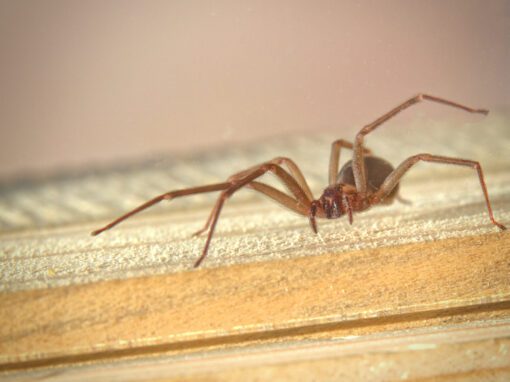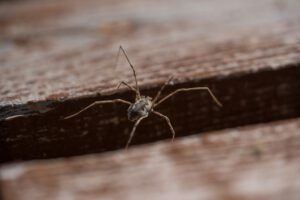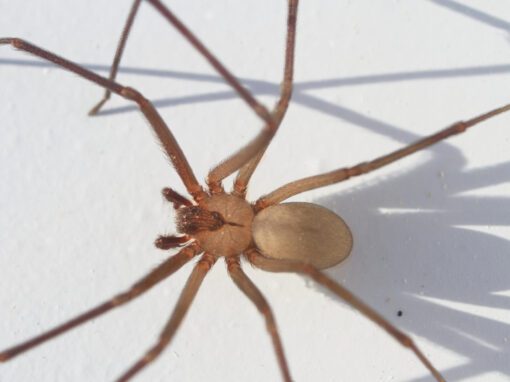If you’ve found yourself here, chances are one of these situations sounds familiar:
- You or someone in your family has a mysterious bite, and you’ve started searching online for answers.
- You spotted a suspicious brown spider in the basement or laundry room, and your heart skipped a beat.
- Someone in the house yelled, “Is this a brown recluse?” and now you’re the one investigating.
- You’ve heard the stories and just want to know if it’s something to worry about.
We completely understand. Seeing a spider that might be a brown recluse can be unnerving, especially when you are trying to keep your home safe and your family calm. Before you panic, let us walk through a few simple facts that can help you figure out what you are really dealing with.
Brown Recluse Bites Are Very Rare
Despite all the talk about how dangerous these spiders can be, actual brown recluse bites are very rare. According to arachnologists and entomologists across the country, most people who think they have been bitten by a brown recluse were not bitten by one at all. Many other common spiders or even minor skin irritations are often mistaken for recluse bites.
- These spiders like to hide in quiet, undisturbed places, which is how they got their name. They usually only bite when they feel very threatened or trapped against the skin.
- Brown recluses are native only to certain parts of the Midwest, including southern Indiana, southern Illinois, Missouri, and parts of Iowa and Kansas.
- More than 90 percent of brown recluse bites cause little to no reaction. Only a very small number of people who are bitten experience serious symptoms or complications.
It is unlikely that you have actually come into contact with a brown recluse spider. So what did you see instead, or what might have bitten you? Here are four common spiders found in urban and rural areas across the Midwest that are often mistaken for brown recluses:
DISCLAIMER: Before you worry, keep in mind that spider bites all look very similar. You can’t identify the culprit from the bite alone—you’d have to catch the spider in the act!
1. Cellar Spider (also known as “Daddy Long Legs”)
Looks like: Small (2-10mm) elongate body, very long, thin legs (about 5x their body length!), pale brown or gray.
Habits: Prefers basements, garages, and crawlspaces. It often settles in the corners of rooms or along baseboards and builds messy, cobweb-like webs.
Bites? May TRY to bite if it is handled or feels threatened, but its mouth is too small to cause any harm to human skin.
2. Wolf Spider
Looks like: Large (up to 1 ¼ inches), hairy, brown or gray with a light, vertical stripe down the middle, surrounded by two dark stripes. Fast-moving.
Habits: DOES NOT build webs. Often found near doors, garages, and piles of outdoor debris
Bites? Can bite if it is handled or accidentally trapped against the skin. Any symptoms are usually mild, such as redness or localized swelling, similar to a small bee sting.
3. Grass Spider (also called funnel spider)
Looks like: About ½ inch, brown or tan with dark stripes running lengthwise, similar to a wolf spider. Small, diamond-shaped abdomen with spinnerets that stick out at the back. (those are the organs spiders use to make silk!)
Habits: Builds funnel-shaped webs in grass or bushes. It is fast-moving and will dart out quickly if its web is disturbed.
Bites? Bites from this spider are very rare because it is shy. If a bite does occur, symptoms may include pain, redness, itching, and swelling.(very similar to a bee sting).
4. House Spider (also called cobweb spider)
Looks like: Small (1/8th to 1/4th of an inch), rounded body with mottled patterns.
Habits: Builds multiple webs in damp, undisturbed areas such as basements, crawlspaces, garages, or barns.
Bites? VERY rarely bites, but there have been a few recorded cases of house spider bites, which can cause pain, redness, and swelling.
Tips for Telling if It Is a Brown Recluse
If you think you have spotted a brown recluse spider, here are the key features to look for.
- About ½ inch in size, light to medium brown and has a distinct violin-shaped marking on its back.
- Six eyes arranged in three pairs, unlike most spiders which have eight.
- The legs have no markings or bands.
- The legs are very thin and spindly, unlike the hairy legs of a wolf spider.
- Found in undisturbed areas such as behind baseboards, inside shoes or boxes, and in basements or attics.
Still unsure? That is completely normal, and you are not alone.
Need Help Figuring Out What Spider You Found?
At Franklin, we are a family-owned pest control company right here in the Midwest. If you find a spider and want a second opinion, just send us a photo. emailus@franklinpestsolutions.com We are happy to help you identify it at no cost.
If you are ready to take proactive steps, we also offer free quotes for spider prevention and control services for your home, garage, basement, or business.







